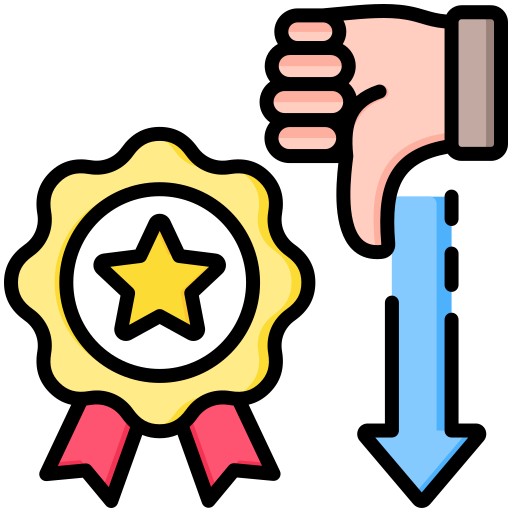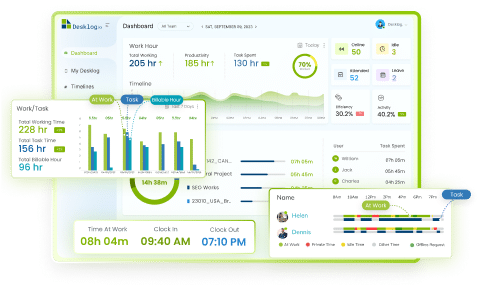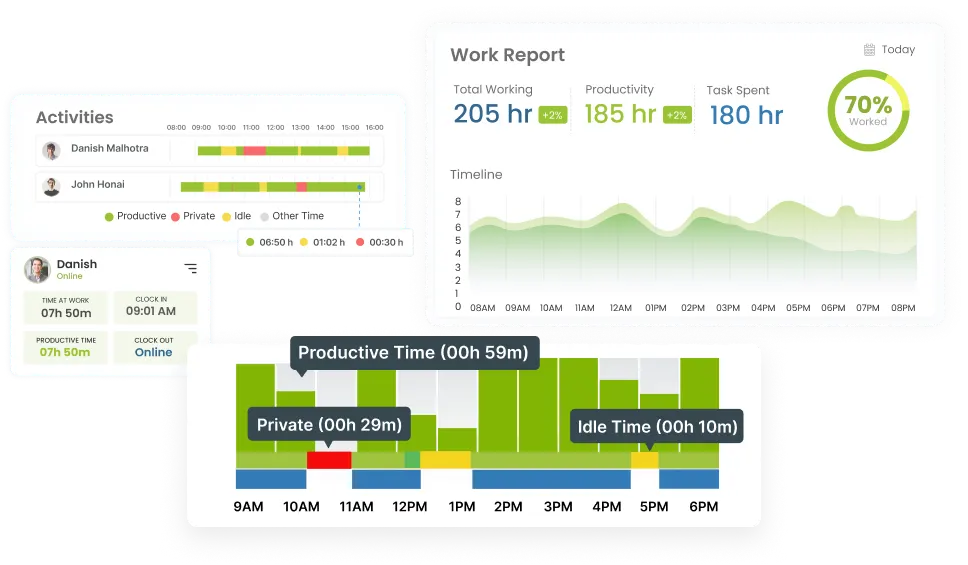Tick, tock, tick, tock – time is more than just hands moving around a clock. In the world of business
and project management, it’s the currency we trade in. It is the invisible force that can make or break
a venture.
In simple words, time cost is the loss incurred from projects taking longer than expected. It’s not just
about hours slipping away; it’s about the value lost or gained with every passing moment.
Time cost is a race against the clock where every second counts. So buckle up as we dive into the
aspects of time cost and how it affects your business.
What is Time Cost?
Time cost is the indirect expenses accrued when an activity surpasses its predicted duration. It includes tangible expenditures like labor costs, alongside intangible elements such as missed opportunities and decreased productivity.
Internal and External Time Cost
Time cost can be categorized into two : internal and external. Understanding the differences between these two types is crucial for effectively managing projects and making informed decisions.
Internal Time Cost:
Internal time cost refers to the expenses incurred within the organization or project itself. These costs are directly associated with the resources used and the activities performed during the project execution. Examples of internal time costs include:

Labor Expenses:
The wages or salaries paid to employees working on the project.

Equipment Usage:
Costs related to using machinery, tools, or other resources necessary for project completion

Overhead Costs:
Indirect expenses such as utilities, rent, and administrative expenses that contribute to the overall cost of the project
External Time Cost:
External time cost, on the other hand, extends beyond the boundaries of the organization or project and encompasses broader implications. These costs often arise from delays or disruptions in the external environment that impact project timelines and outcomes. Examples of external time costs include:

Penalties and Fines:
Charges imposed by external entities for delays or non-compliance with contractual obligations.

Market Losses:
Decreases in market share or revenue resulting from delayed product launches or project completion.

Reputation Damage:
Negative publicity or loss of trust from stakeholders due to project delays or failures.
Managing external time costs requires proactive risk management strategies and effective communication with external stakeholders to mitigate potential impacts.
What Is Time Cost Optimization ?
Time cost optimization refers to finding ways to get things done faster and using fewer resources. It’s about making smart choices to save time and money, like figuring out the best order to do tasks or using tools that help you work quicker. It’s like taking a shortcut to get to your destination faster. It’s about how you manage your time and effort to achieve your goals more efficiently.
How Time Cost Affects Your Business ?
Time cost can significantly impact various aspects of your business, including project management, workflows, productivity, budgets, decision-making, and product quality:
Project Management:
Inefficient workflows lead to wasted time and resources. Optimizing workflows reduces time spent on unnecessary steps and enhances overall efficiency.
-
Streamlining workflows minimizes bottlenecks and ensures smoother operations, enabling teams to accomplish more in less time.
Workflows:
-
Time cost directly impacts productivity by determining how efficiently resources are utilized.
-
Improving time management practices enhances productivity by enabling employees to focus on high-priority tasks and complete them more quickly.
Productivity:
-
Time cost directly impacts productivity by determining how efficiently resources are utilized.
-
Improving time management practices enhances productivity by enabling employees to focus on high-priority tasks and complete them more quickly.
Budgets:
-
Time is a valuable resource that directly affects the financial aspects of a business.
-
Delays and inefficiencies increase labor costs, extend project durations, and may require additional expenditures to meet deadlines, leading to budget overruns.
Decision Making:
-
Time constraints often influence decision-making processes.
-
Effective time management allows for thorough analysis and evaluation of options, leading to better-informed decisions that align with business objectives and maximize returns.
Product Quality:
-
Rushing through tasks due to time constraints can compromise product quality.
-
Effective time management allows for Adequate time allocation allows for proper planning, testing, and refinement, resulting in higher-quality products that meet customer expectations and enhance brand reputation.
Identifying Time Cost Culprits
Several factors contribute to time cost within organizations. Identifying these culprits is essential for effective time management and optimization. Here are some common ones:

Inefficient Workflows: Complex or convoluted processes can lead to delays and inefficiencies, wasting valuable time and resources.

Multitasking: Juggling multiple tasks simultaneously can decrease productivity and effectiveness as attention is divided, leading to longer completion times for each task.

Poorly Defined Tasks: Unclear or ambiguous task instructions can result in misunderstandings, mistakes, and rework, prolonging the time needed to complete projects.

Distractions: Interruptions from emails, phone calls, social media, or colleagues can disrupt workflow and decrease focus, increasing the time required to accomplish tasks

Procrastination: Delaying tasks or postponing decisions can prolong project timelines and lead to rushed or last-minute efforts, compromising quality and efficiency.

Scope Creep: Uncontrolled expansion of project scope or frequent changes in requirements can extend project durations and increase resource consumption, resulting in higher time costs.
Unique Challenges of Managing Time Cost in Remote Work Environments
Remote work introduces additional complexities and challenges that can exacerbate time cost issues. Here are some unique challenges:
Communication Gaps:
Reduced face-to-face interaction can lead to miscommunication, misunderstandings, and delays in information sharing, affecting project progress and coordination.
Lack of Visibility:
Managers may have limited visibility into remote workers’ activities, making it challenging to monitor progress, track productivity, and address potential bottlenecks effectively.
Dependency on Technology:
Reliance on digital tools and communication platforms introduces the risk of technical glitches, connectivity issues, and learning curves, which can disrupt workflow and impede productivity.
Time Zone Differences:
Working across different time zones can create scheduling conflicts, delays in response times, and difficulties in coordinating collaborative efforts, prolonging project timelines.
To overcome the challenges of remote work and manage time better, companies can take simple steps.
Establish clear communication rules and hold regular meetings to keep remote teams aligned.
Utilize tracking tools to monitor progress and provide assistance to remote workers as needed.
Provide reliable technology and training to ensure seamless remote work operations.
Be flexible with schedules and encourage teamwork to bridge time zone gaps.
Prioritize employee well-being and foster a supportive culture to enhance motivation and productivity.
Strategies to Minimize Time Cost
Employee Time Management Techniques
Here are some techniques to help employees manage their time effectively:
Time Tracking with Advanced Tools:

Use time tracking software to automatically track time spent by employees throughout the day. These tools provide insights into time usage patterns by effectively tracking offline time, idle time, project time, identifying time sinks, and facilitating better time allocation.

These softwares can track app and url usage which helps the employers make sure employees don’t waste time on unproductive apps.
Setting Priorities Using Frameworks like OKRs (Objectives and Key Results):

Implement goal-setting frameworks such as OKRs to help employees prioritize tasks and focus on activities that align with organizational objectives. By defining clear objectives and key results, employees can allocate their time more effectively to tasks that contribute the most value.
Task Prioritization Techniques:

Encourage employees to use techniques like the Eisenhower Matrix (urgent vs. important) or the ABCDE method (assigning priorities to tasks) to prioritize their workload. By categorizing tasks based on urgency and importance, employees can allocate time to high-priority activities first.
Time Blocking:

Encourage employees to block out specific time slots in their schedules for different types of tasks, such as meetings, focused work, and breaks. This helps create a structured routine and minimizes distractions, allowing for more efficient use of time.
Limiting Distractions:

Provide guidelines or best practices for minimizing distractions, such as turning off notifications, setting specific times for checking emails, or utilizing tools to block distracting websites during focused work periods. By reducing interruptions, employees can maintain better focus and productivity.
Regular Breaks and Time Off:

Encourage employees to take regular breaks and time off to recharge and avoid burnout. Providing opportunities for rest and relaxation can improve overall productivity and well-being, leading to better time management in the long run.
Continuous Learning and Skill Development:

Invest in training programs and resources to help employees improve their time management skills. Providing education on time management techniques and productivity tools equips employees with the knowledge and tools they need to manage their time more effectively.
Minimizing Workplace Distractions
To maintain focus and productivity, organizations can employ several strategies:
Clear Communication Guidelines:
Establish protocols for communication channels and meeting schedules to minimize interruptions.
Focus Tools:
Provide noise-canceling headphones, productivity apps, and time management techniques like the Pomodoro Technique.
Setting Boundaries:
Encourage employees to signal when they’re unavailable and respect each other’s work time.
Regular Breaks:
Promote short breaks to prevent burnout and maintain mental clarity.
Encouraging Physical Activity:
Support movement breaks to reduce fatigue and improve concentration.
Dedicated Workspaces for Remote Workers:
Encourage remote employees to create distraction-free home offices.
Technology and Automation in Streamlining Workflows
Technology plays a crucial role in automating tasks and streamlining workflows, leading to
increased efficiency and productivity in various industries. Specific project management and
time tracking software can significantly contribute to this process.
Time tracking software like Desklog, Toggl, Harvest, or
Clockify automates the tracking of hours
spent on different tasks or projects. Employees can easily log their time, categorize
activities, and generate reports, eliminating the need for manual timekeeping and reducing
administrative overhead.
Benefits of Automated Time Tracking Tools
Project Time Management:
Automated time tracking tools provide valuable insights into how time is allocated across different projects. By accurately recording the time spent on various tasks and activities, these tools enable project managers to better monitor progress, identify bottlenecks, and allocate resources effectively. This enhances project time management by ensuring that tasks are completed on schedule and project timelines are met efficiently.
Automated Timesheets:
Automated time tracking tools streamline the process of generating timesheets by automatically recording and compiling employees’ work hours. This eliminates the need for manual data entry, reducing errors and administrative overhead. With automated timesheets, managers can quickly review and approve timesheets, ensuring accurate and timely payroll processing. This saves time and effort for both employees and managers, leading to increased efficiency in time management
Absence Management:
Automated time tracking tools can also facilitate absence management by tracking employees’ leave and attendance automatically. By recording vacation days, sick leave, and other types of absences in real-time, these tools provide managers with up-to-date information on employees’ availability. This helps in managing staffing levels, planning for resource allocation, and ensuring compliance with company policies and regulations regarding time off. Additionally, automated absence management reduces the administrative burden associated with manual tracking and approval of leave requests.
Shift Management:
Automated time tracking tools simplify shift management by allowing employees to clock in and out electronically based on their assigned schedules. This ensures accurate recording of work hours and provides managers with visibility into employee attendance and punctuality. Additionally, these tools can help in optimizing shift schedules, ensuring adequate coverage during peak hours and minimizing overtime costs. By automating shift management processes, organizations can improve workforce productivity, reduce labor costs, and enhance overall time management efficiency.
Process Improvement
Regularly reviewing and improving business processes is paramount for organizational success. Here’s why:
Efficiency Boost:
Continuously assessing processes helps identify and eliminate time-wasting activities, streamlining operations and maximizing productivity.
Cost Reduction:
By eliminating inefficiencies, organizations save valuable resources and reduce unnecessary expenses, contributing to overall cost-effectiveness.
Adaptability:
In today’s dynamic business landscape, continuous improvement ensures adaptability to changing market conditions, maintaining competitiveness and relevance.
Enhanced Performance:
Optimized processes enable tasks to be completed more quickly and with fewer resources, leading to improved performance and outcomes.
Data Analytics and Measurement in Time Cost Management
Data analytics helps businesses understand how time is spent and how to make it more efficient. Here’s how it works:
Finding Time-Consuming Tasks:
By looking at data on how time is used, businesses can figure out which tasks take the longest. This helps them focus on improving those tasks to save time and money.
Keeping Track of Projects:
Businesses can use data to see how their projects are progressing. By comparing planned time with actual time spent, they can spot problems early and fix them to stay on track.
Seeing How They Measure Up:
Data lets businesses compare their performance to others in the industry. This helps them figure out where they’re doing well and where they can improve.
Predicting Future Time Costs:
Advanced data techniques can even help predict how much time future projects will take. This lets businesses plan ahead,avoid delays and enhance business efficiency.
Conclusion:
Time cost is a critical issue and it needs all your attention. We have discussed various ways to
avoid losses. From identifying time-consuming tasks to tracking project progress, from optimizing
workflows to predicting future costs, tools ensure each step is efficient.
We must also equip ourselves with the skills and techniques to navigate the turns of time
management. We have an array of tools at our disposal.
It is not just about winning the race against the clock; it’s about making every second count in the
road to success.
FAQ
1 What is time cost in business?
Time cost in business refers to the monetary value associated with the time spent on various activities or projects within an organization.
2 How does time affect the cost of a project?
Time directly impacts the cost of a project by influencing labor expenses, resource allocation, and potential delays, all of which can increase overall project costs.
3 What does time to cost mean?
Time to cost refers to the relationship between the duration of a project or activity and its associated expenses. It highlights the importance of efficient time management to control project expenditures.
4Why is time and cost important?
Time and cost are crucial factors in business because they directly impact profitability, resource utilization, and project success. Effective management of time and cost ensures efficiency, competitiveness, and financial sustainability for organizations.



 Inefficient workflows lead to wasted time and resources. Optimizing workflows
reduces time spent on unnecessary steps and enhances overall efficiency.
Inefficient workflows lead to wasted time and resources. Optimizing workflows
reduces time spent on unnecessary steps and enhances overall efficiency.














